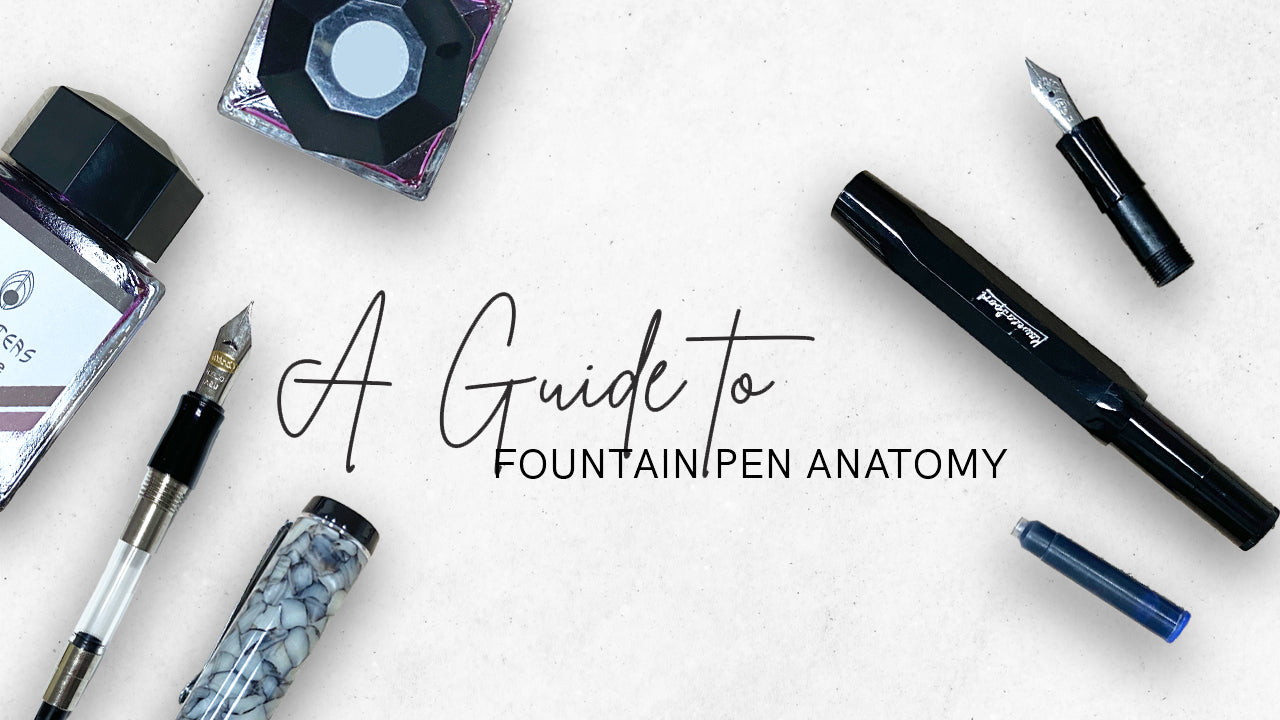A Guide to Fountain Pen Anatomy

The fountain pen is a fascinating invention. When it comes to this unique writing tool, looks can be deceiving. For most beginners, a fountain pen can seem intimidating especially if you compare it to a simple ballpoint pen.
In this blog post, we’ll get down to the nitty gritty of fountain pen anatomy so that you can get a better understanding of it and see why it’s nothing you can’t handle!
Before we go deeper into each feature of a fountain pen and its function, let’s take a look at the overall anatomy. Here I’ve placed 2 different types of fountain pens side by side: a Conklin that uses a converter and a Kaweco that uses a cartridge.
Besides the way ink is refilled and stored in each pen, majority of the features remain the same. Most fountain pens always comes with a screw-on cap for maximum security and a barrel to hide and protect your cartridge or converter with.
Most fountain pens separate their converters and cartridges when you receive them but TWSBI fountain pens are unique in that their pens are able to fill itself without a converter due to its piston filler mechanism.
FEATURES AND FUNCTIONS

THE NIB
Let’s start at where the action happens: the nib. In A Guide to Fountain Pens (2020), I touched briefly on what the nib does. To give you a recap, the nib is basically where ink is transferred to the paper.
Nibs are typically made in either gold or stainless steel and come in 5 different sizes: extra fine, fine, medium, broad and stub (Also known as BB). These nibs are also collectively known as ’round nibs’.
Nibs are an important factor to consider when you’re buying a fountain pen as they can affect the way your writing penmanship turns out. If you want a visual guide, here’s a video of us comparing 5 nib sizes!

THE FEED
The nib and feed go hand-in-hand. A nib is useless without a feed and that’s because it is through the feed that the nib is supplied with ink.
A feed is the bridge between the ink reservoirs (a converter or a cartridge) and the nib. Fins hidden inside the feed help regulate ink with capillary action, allowing it to flow down at a controlled rate.
It’s important to note that a feed can only work properly if the right ink is used. Non-fountain pen inks can contain binding agents which will damage your feed.
A feed is not always visible especially if your fountain pen doesn’t have a transparent body but it nonetheless plays a very vital role in the mechanics of a fountain pen!
DIFFERENCE BETWEEN A CONVERTER AND A CARTRIDGE

- A cartridge is a pre-packaged ink refill sold in packs that you can pop into a fountain pen
- A converter is a single syringe like mechanism that allows you to draw ink from an ink bottle
PROS & CONS OF A CARTRIDGE VS CONVERTER
Each are ink reservoirs that allow you to store ink. So how do they differ from the other?

Pros:
- Convenient
- Refills quickly
- Portable
- Inexpensive
- Can be used in select fountain pens that come with converters
Cons:
- Limited ink colours
- Limited ink volume
- Environmentally unfriendly
- Certain brands require brand specific ink cartridges

Pros:
- Large ink volume
- Large variety of colours available for refill
- Environmentally friendly
- Economical
Cons:
- Messy
- Ink bottles are bulky
- Expensive
- Requires more care and attention when refilling
- Cannot fit in fountain pens with shorter barrels
FINAL THOUGHTS

While it might seem like cartridges are the better options due to it having more advantages, it once again comes down to your own preference.
Personally, for the long run, I would say I definitely prefer the converter and ink bottle combo. I write a lot so it really frustrates me when I run out of ink before I finish any of my pieces. The fact that it’s not only environmentally friendly but comes in an assortment of beautiful colours is also a huge plus for me. I love vintage coloured inks and a cartridge just doesn’t provide that kind of possibility.
Watch: How to Install a Kaweco Standard Converter

Although the converter and ink bottle is a clear victor for me, the cartridge edges the converter with one simple factor: convenience. For those who like to do journaling on-the-go, you’ll love the cartridge for its portability and fuss-free refilling. Unlike the converter which requires more time to be refilled and cleaned, the cartridge refills with a simple pop-in. If you’re a beginner, you might want to ease yourself into refilling with cartridges before moving on to bottled inks.
Watch: How to install Ink Cartridges
Now that you have a better idea of how a fountain pen works, let us know whether you’re team cartridge or team converter!








